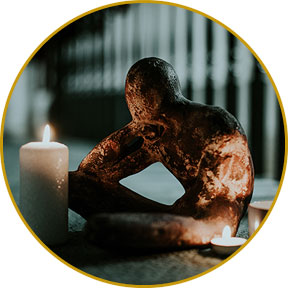Bringing Death Back to Life – How We Could Talk to our Children

I remember when I was young living and playing with ‘reckless abandon’ whether it be on the ice hockey rink, in the back yard, or the family playroom. It was this full on life energy in action. It, well actual I, didn’t fit well in a box, I was a handful to try and contain, and I didn’t ‘behave’ myself at least according to others. I was so full of life.
Well that changed a little for me when my grandpa Joe died way back in the late 1950’s perhaps early sixties. I think I was ten or eleven. Us kids didn’t know about funerals, caskets, viewings and all that sort of taboo death stuff. We did know grandpa was dead but not much more that than.
At the funeral home I was full of questions. Questions that the adults present, including my parents, seemed most unwilling to confront.
“Why was grandpa in a box?”
“Why was he wearing a suit and tie?”
“What was he doing with makeup on his face?”
“Why was his skin cold?”
“Can I hug him good-bye, and where is he going?”
The answers to my curious, and numerous questions were “shhh!” Or “not now” or “don’t ask so many questions.” I ultimately found myself outside with a few other children so the adults could say a proper good-bye without any childish interruptions. What disturbed me most was not the grandpa Joe was dead but that no one was helping me make sense of it or helping me to understand what death meant and what at the funeral stuff was about.
I felt like there was something wrong, something that kids shouldn’t know about what had just happened. I got scared. I started to have a recurring dream of me crossing a six-lane highway and stumbling and getting up. As the cars came closer I would stumble more and get up more quickly and stumble more quickly and the cars would get closer and wham! I would wake up in a cold sweat, scared out of my wits. Frightened to death.
Now I can’t say for sure and absolutely it is all conjecture but what could have happened if my parents and adults around me at grandpa’s funeral had of handled my questions this way, in a way that honored death as a fundamental and important aspect of a full life;
“Why was grandpa in a box?”
Well honey it is called a casket and we have put grandpa so we can say good-bye and bury him in the cemetery.
“Why was he wearing a suit and tie?”
We dressed him in a suit and tie as a form respect for him and his life. It is sort of like getting dressed up for an important occasion.
“What was he doing with makeup on his face?”
When we die honey the skin looses its color and grandpa was very pal. The makeup is to make grandpa Joe look like he did when he was alive.
“Why was his skin cold?”
When our body dies our heart stops and our blood does flow anymore. Remember last winter when our furnace broke down and the house got cold. It is a little like that son.
“Can I hug him good-bye, and where is he going?”
You sure can. Let me lift you up so you can.
These answers would have been natural, honest, spoken in the way a child can understand and they didn’t shy away from the topic of death, they faced calmly and humanly. I still would have been sad of course but I wouldn’t have been scared. The adults’ answers were letting me know I was capable of dealing with grandpa’s death.
So indeed let us bring death back to life an enable our young ones to handle the challenges of life by facing death, loss, and grief head on, gently and in terms they can understand.
